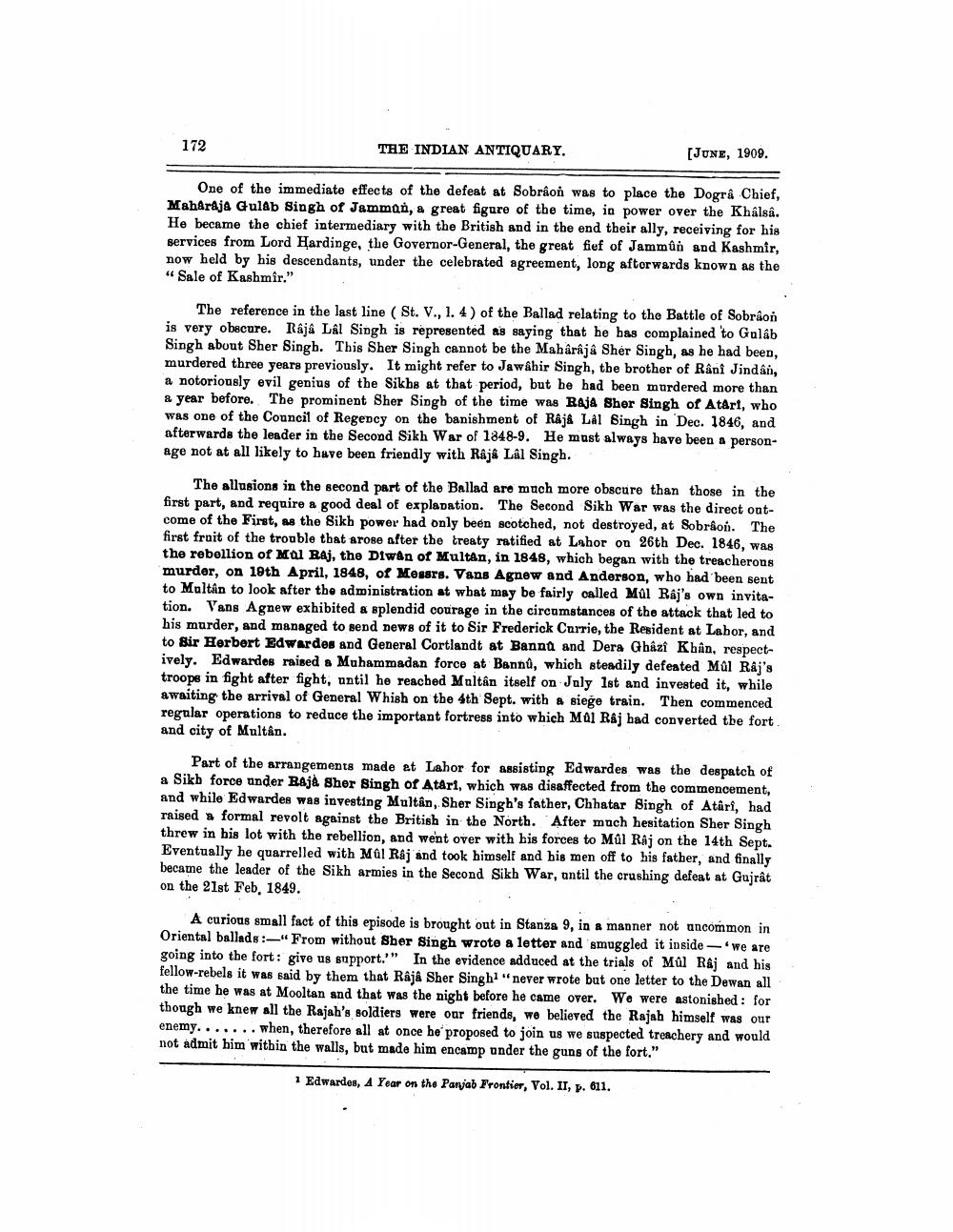________________
172
THE INDIAN ANTIQUARY.
[JUNE, 1909.
One of the immediate effects of the defeat at sobraon was to place the Dogrâ Chief, Maharaja Gulab Singh of Jamman, a great figure of the time, in power over the Khälsa. He became the chief intermediary with the British and in the end their ally, receiving for his services from Lord Hardinge, the Governor-General, the great fief of Jammu and Kashmir, now held by his descendants, under the celebrated agreement, long afterwards known as the “Sale of Kashmir."
The reference in the last line ( St. V., 1. 4) of the Ballad relating to the Battle of Sobraon is very obscure. Raja Lal Singh is represented as saying that he has complained to Gulab Singh about Sher Singh. This Sher Singh cannot be the Mahârâjâ Sher Singh, as he had been, murdered three years previously. It might refer to Jawahir Singh, the brother of Rânî Jindan, a notoriously evil genius of the Sikhs at that period, but he had been mordered more than & year before. The prominent Sher Singh of the time was RAJA Sher Singh of Atari, who was one of the Council of Regency on the banishment of Raja Lal Singh in Dec. 1846, and afterwards the leader in the Second Sikh War of 1848-9. He must always have been a personage not at all likely to have been friendly with Raja Lal Singh.
The allusions in the second part of the Ballad are much more obscure than those in the first part, and require a good deal of explanation. The Second Sikh War was the direct outcome of the First, as the Sikh power had only been scotched, not destroyed, at Sobraon. The first fruit of the trouble that arose after the treaty ratified at Lahor on 26th Dec. 1846, was the rebellion of Mal Raj, the Diw&n of Multan, in 1848, which began with the treacherons murder, on 19th April, 1848, of Messrs. Vans Agnew and Anderson, who had been sent to Moltán to look after the administration at what may be fairly called Múl Raj's own invitation. Vans Agnew exhibited a splendid courage in the circumstances of the attack that led to his murder, and managed to send news of it to Sir Frederick Currie, the Resident at Labor, and to Sir Herbert Edwardes and General Cortlandt at Bannt and Dera Ghazi Khân, respectively. Edwardes raised a Muhammadan force at Bannú, which steadily defeated Mûl Raj's troops in fight after fight, until he reached Multân itself on July 1st and invested it, while awaiting the arrival of General Whish on the 4th Sept. with a sieğe train. Then commenced regular operations to reduce the important fortress into which Mol Raj bad converted the fort. and city of Multân.
Part of the arrangements made at Lahor for assisting Edwardes was the despatch of a Sikb force under Raj, Sher Singh of Atari, which was disaffected from the commencement, and while Edwardes was investing Multan, Sher Singh's father, Chhatar Singh of Atari, had raised a formal revolt against the British in the North. After much hesitation Sher Singh threw in his lot with the rebellion, and went over with his forces to Múl Raj on the 14th Sept. Eventually he quarrelled with Mai Raj and took himself and his men off to his father, and finally became the leader of the Sikh armies in the Second Sikh War, until the crushing defeat at Gujrât on the 21st Feb. 1849.
A curious small fact of this episode is brought out in Stanza 9, in a manner not uncommon in Oriental ballads :-"From without Sher Singh wrote a letter and smuggled it inside - we are going into the fort: give us support.'" In the evidence adduced at the trials of Mûl Raj and his fellow-rebels it was said by them that Râjâ Sher Singhi "never wrote but one letter to the Dewan all the time he was at Mooltan and that was the night before he came over. We were astonished : for though we knew all the Rajah's soldiers were our friends, we believed the Rajah himself was our enemy. . . . . . . when, therefore all at once he proposed to join us we suspected treachery and would not admit him within the walls, but made him encamp under the guns of the fort."
1 Edwardos, A Year on the Panjab Frontier, Vol. II, p. 611.




